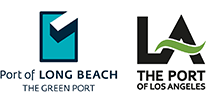About the Committee
The Sustainable Supply Chain Advisory Committee convenes a diverse set of stakeholders from business, labor, environment, community and regulatory sectors with interest in the southern California ports.
The SSCAC meets on a bi-monthly basis with the Ports of Long Beach and Los Angeles to address challenges and opportunities for improving sustainability within the goods movement sector.
The SSCAC was originally established in June 2016 by Los Angeles Mayor Eric Garcetti, for the purpose of making recommendations to Port of Los Angeles and the Los Angeles mayor on strategies to make continual progress in improving the efficiency of and reducing emissions from cargo movement, while balancing commercial and economic sustainability.
In December of 2017, the Committee was expanded to include the Port of Long Beach. Today, recommendations from the Committee are addressed to the Port of Long Beach executive director and Long Beach mayor, in addition to their Los Angeles counterparts.
Statement of Mission and Vision
Purpose
The Committee’s purpose is to evaluate technologies and make advisory recommendations to both ports’ executive directors for moving cargo more efficiently and with zero emission technology everywhere feasible, and near-zero emission technology powered by renewable fuels everywhere else. Using innovation, market transformation, and other tools, the Committee will also be tasked to help the San Pedro Bay Ports achieve and exceed the goals set forth in the State’s Sustainable Freight Action Plan while addressing economic and commercial needs.
Goals
The State’s Sustainable Freight Action Plan goals of note for the Committee include:
- Improve freight system efficiency 25 percent by increasing the value of goods and services produced from the freight sector, relative to the amount of carbon that it produces by 2030
- Deploy more than 100,000 freight vehicles and equipment capable of zero emission operation and maximize near-zero emission freight vehicles and equipment powered by renewable energy by 2030
- Foster future economic growth within the freight and goods movement industry by promoting flexibility, efficiency, investment, and best business practices through State policies and programs that create a positive environment for growing freight volumes, while working with industry to lessen immediate potential negative economic impacts
The San Pedro Bay Ports’ Clean Air Action Plan goals of note for the Committee include:
- Reduce population-weighted residential cancer risk of Port-related DPM emissions by 85% by 2020, as compared with 2005 conditions.
- Reduce port-related emissions by 59 percent for NOx, 93 percent for SOx and 77 percent for DPM by 2023, as compared with 2005 conditions.
- Reduce GHGs from port-related sources to 40% below 1990 level by 2030 and 80% below 1990 levels by 2050.
Values and Guidelines
As the Committee discusses possible recommendations, the following values and guidelines should be considered:
- Near-term pilots that are scalable, advance zero emissions targets, and help transform markets
- Focus on the largest sources of emissions with near-term and currently available technologies that meet economic and commercial needs
- Cost-effective investments with environmental, economic, and technological sustainability that also drive long-term market transformation
- Protecting human health, especially in port-adjacent communities, by accelerating the deployment of zero and near-zero emission technologies

